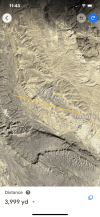I am setting up a range for up to 4,000 yards. I want to use a simple GPS for measurements. Not sure which ones will work. BUT....I DON'T NEED MAPS!! All I need is the ability to mark both ends of the path and have it calculate the distance. Assuming level ground. Even without the calculator I could use pencil and paper to calculate it if the unit would give me the GPS positions. It seems that most small handheld units are geared to using maps and land marks, not just raw GPS.
But there may be some out of the box solutions as well.
1) is there a program for tracking that will use my phone to find a tagged object and give me the distance to that object?
2) Since my phone does have GPS information that is accessible to the police, how can I access that information?
3) maybe time the bullet from firing line to target? That would be hard without very accurate instruments.
Any other ways other than a 3 mile tape measure?
Response:
1) Google maps will do that. Drop a pin at one location, go to another and you can get the distance to the pin.
2) Direct access to GPS information on your phone is difficult at best, and not very useful. Physical access yo your phone might be required.
The apps you use (such as Google maps) send the location derived from GPS data it to Google (or whomever), Google generates maps and other information which is returned to your phone via the internet. The data going to/from you and your service provider and the application provider is much more useful & accessible to police (and others).
If you download local maps of an area to your phone you can probably do what you want offline but I'm not sure if Maps sends location data to Google after you reconnect. Data that police (and others) might access is what you see on your application history.
Turn on the option for "precision location services" on your phone for better accuracy. This requires internet access and access to at least 3 cell towers from the location of interest.
3} A surveyor with a transit can probably do better but it could be very costly if reference markers are far away, which is likely since you're probably in an isolated area.
A surveyor with better GPS equipment (i.e. dual channel with more advanced algorithms) could get you down to a few centimeters or even less if you leave the equipment sitting at a position for several days. This equipment is expensive, you probably don't want to buy it.
Other thoughts:
If you are interested in seeing the raw GPS data as sent from satellites, I'm not sure of any commercial app to display it. The raw data is useless to most people, only developers working on GPS-based equipment or software would really dig into it & the reams of data needed to understand it. Most companies that want to include GPS on a new product would buy a design from somebody else because of the difficulty & cost involved.
Basic GPS like on your phone isn't that accurate (4.9 meters/16 feet radius horizontally and 1.7 times that vertically about +/- 8.3 meters/27.3 feet). That is about 0.27% horizontal error at each location, 0.54% total.
Dual-channel GPS (which is what the military and some commercial users use), can get you to a few centimeters or even millimeters if you leave the equipment in place for days. It is expensive and bulky. You might find a surveyor that has it.
Your mobile phone usually has an option for higher accuracy location services (look for precision, high precision, high accuracy location services). This doesn't use GPS, the implementation needs to hit several cell towers, the cell tower equipment measures the signal strength at each tower, then an algorithm uses this along with the tower locations to triangulate your position, the position is sent to your phone and/or application via the internet. There are several refinements that can improve accuracy further. The accuracy of this depends on your mobile service provider's specific implementation and your location. Towers near a remote location are probably going to be far away, which would probably result in greater error than if you were close to the towers.



